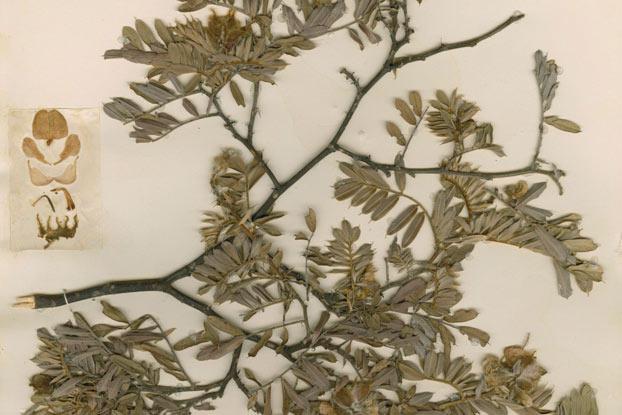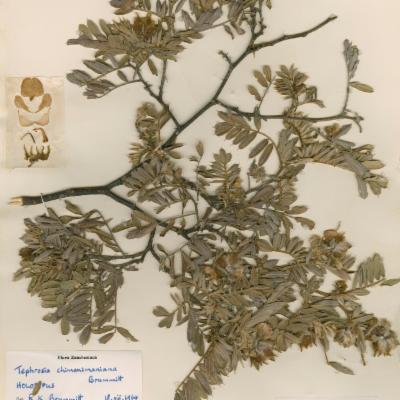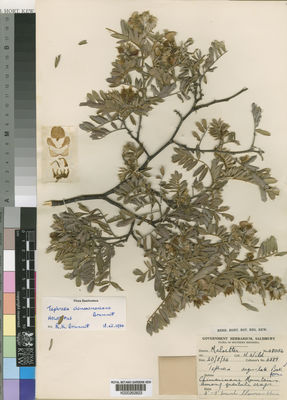-
General Description
-
A Near Threatened shrub belonging to the pea and bean family,
Tephrosia chimanimaniana is restricted to the Chimanimani Mountains in eastern Zimbabwe.
Tephrosia chimanimaniana is a perennial shrub belonging to the pea and bean family (Leguminosae). It is most closely related to T. grandibracteata, a somewhat larger shrub restricted to the broad Nyanga area in eastern to central Zimbabwe.
The generic name is derived from the Greek word tephros, meaning 'ash-coloured', referring to the greyish tint of the leaves resulting from their dense trichomes (hairs). The specific epithet chimanimaniana refers to the region in which it is found - the Chimanimani Mountains.
-
Species Profile
-
Geography and distribution
Restricted to the Chimanimani Mountains in the Chimanimani District of eastern Zimbabwe.
It occurs from the foot of the first mountain range to the quartzite crags, up to at least 2,135 m above sea level. The Chimanimani Mountains contain many plant species that do not occur elsewhere (endemic species).
Description
Overview: Tephrosia chimanimaniana is a perennial shrub 0.3-2 m high. The young branches are densely covered with brown or greyish hairs.
Leaves: The leaves have 5-12 pairs of leaflets. The leaflets are somewhat leathery and up to 30 × 10 mm. The stipules (appendages at the base of leaf stalks) are narrowly triangular and 4-5 × 1-1.5 mm.
Flowers: The attractive, deep pink to purple flowers are borne in subspherical terminal heads exceeded by the leaves. The bracts are large and usually conspicuous, and are up to 14 × 9 mm. The whitish, hairy pedicels (stalks of individual flowers) are 5-7 mm long. The calyx is 7-10 mm long, with a dense covering of brown to whitish hairs. The petals are 13-15 mm long. The stamen tube is about 9 mm long. The ovary and style are covered in short, fine hairs.
Fruits: The details of the pods are unknown.
Threats and conservation
There are no known conservation measures specifically for Tephrosia chimanimaniana , but it is known to occur within the Chimanimani National Park. Because its distributional range is restricted to an area of only about 180 km², it has been rated as Near Threatened (NT) according to IUCN Red List criteria. Samples of seed should be collected and stored as an ex situ conservation measure.
Fire is one of the principal factors governing the distribution of the plant communities of the Chimanimani Mountains, but it is not known whether it represents a specific threat to Tephrosia chimanimaniana .
Illegal gold mining occurs within the Chimanimani National Park boundaries, and can lead to habitat degradation.
Further research and fieldwork is recommended to better understand the conservation status of, and threats to, T. chimanimaniana .
Conservation assessments carried out by Kew
Tephrosia chimanimaniana is being monitored as part of the 'Sampled Red List Index' project, which aims to produce conservation assessments for a representative sample of the world's plant species. This information will then be used to monitor trends in extinction risk and help focus conservation efforts where they are needed most.
This species at Kew
Pressed and dried specimens of Tephrosia chimanimaniana are held in Kew's Herbarium, where they are available to researchers by appointment. The details, including an image, of one of these specimens can be seen online in the Herbarium Catalogue.
-
Ecology
-
Montane grassland, on quartzite.
-
Conservation
-
Near Threatened (NT) according to IUCN Red List criteria.
-
Hazards
-
None known (although other members of the genus Tephrosia are known to be poisonous to fish).




